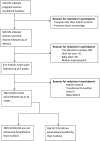Exclusive breastfeeding among HIV exposed infants from birth to 14 weeks of life in Lira, Northern Uganda: a prospective cohort study
- PMID: 33121390
- PMCID: PMC7599030
- DOI: 10.1080/16549716.2020.1833510
Exclusive breastfeeding among HIV exposed infants from birth to 14 weeks of life in Lira, Northern Uganda: a prospective cohort study
Abstract
Background: Breastfeeding is important for growth, development and survival of HIV exposed infants. Exclusive breastfeeding reduces the risk of morbidity, mortality and increases HIV free survival of infants. Evidence on risk factors for inappropriate breastfeeding in Northern Uganda is limited.
Objective: This study determined the risk factors for non-exclusivity of breastfeeding in the first 14 weeks of life.
Methods: This prospective cohort study was conducted among 466 mother-infant pairs between August 2018 and February 2020 in Lira district, Northern Uganda. HIV infected pregnant women were enrolled and followed up at delivery, 6- and 14- weeks postpartum. We used a structured questionnaire to obtain data on socio-demographic, reproductive-related, HIV-related characteristics and exclusive breastfeeding. Data were analysed using Stata version 14.0 (StataCorp, College Station, Texas, USA.). We estimated adjusted risk ratios using modified Poisson regression models.
Results: The proportion of HIV exposed infants that were exclusively breastfed reduced with increasing age. Risk factors for non-exclusive breastfeeding included infants being born to HIV infected women who: were in the highest socioeconomic strata (adjusted risk ratio = 1.5, 95%CI: 1.01- 2.1), whose delivery was supervised by a non-health worker (adjusted risk ratio = 1.6, 95%CI: 1.01- 2.7) and who had not adhered to their ART during pregnancy (adjusted risk ratio = 1.3, 95%CI: 1.01- 1.7).
Conclusions: HIV infected women: with highest socioeconomic status, whose delivery was not supervised by a health worker and who did not adhere to ART were less likely to practice exclusive breastfeeding. We recommend ART adherence and infant feeding counselling to be emphasised among HIV infected women who are at risk of having a home delivery, those with poor ART adherence and those of higher socioeconomic status. We also recommend integration of these services into other settings like homes, community and work places instead of limiting them to hospital settings.
Abbreviations: HIV: Human Immunodeficiency Virus; ART: Antiretroviral therapy; HEI: HIV exposed infant; PMTCT: Prevention of mother-to-child transmission of HIV; MTCT: Mother-to-child transmission of HIV; AFASS: Acceptable, Feasible, Affordable, Sustainable and Safe; LRRH: Lira regional referral hospital; CI: confidence interval; ARR: Adjusted risk ratio; SD: Standard deviation; PCA: Principal component analysis.
Keywords: Breastfeeding; HIV exposed infants; Women living with HIV; exclusive breastfeeding; infant feeding; mixed feeding.
Conflict of interest statement
No potential conflict of interest was reported by the authors.
Figures
Similar articles
-
Incidence of home delivery among women living with HIV in Lira, Northern Uganda: a prospective cohort study.BMC Pregnancy Childbirth. 2021 Nov 10;21(1):763. doi: 10.1186/s12884-021-04222-5. BMC Pregnancy Childbirth. 2021. PMID: 34758766 Free PMC article.
-
Barriers and enablers of adherence to infant nevirapine prophylaxis against HIV 1 transmission among 6-week-old HIV exposed infants: A prospective cohort study in Northern Uganda.PLoS One. 2020 Oct 15;15(10):e0240529. doi: 10.1371/journal.pone.0240529. eCollection 2020. PLoS One. 2020. PMID: 33057393 Free PMC article.
-
Investigation of mother-to-child transmission of HIV in pregnancy and among HIV-exposed infants accessing care at a PMTCT clinic in southwest Nigeria.J Immunoassay Immunochem. 2018;39(4):403-415. doi: 10.1080/15321819.2018.1494607. Epub 2018 Jul 12. J Immunoassay Immunochem. 2018. PMID: 30001188
-
HIV transmission through breastfeeding: problems and prevention.Ann Trop Paediatr. 2003 Jun;23(2):91-106. doi: 10.1179/027249303235002161. Ann Trop Paediatr. 2003. PMID: 12803739 Review.
-
Impact of breastfeeding, maternal antiretroviral treatment and health service factors on 18-month vertical transmission of HIV and HIV-free survival: results from a nationally representative HIV-exposed infant cohort, South Africa.J Epidemiol Community Health. 2020 Dec;74(12):1069-1077. doi: 10.1136/jech-2019-213453. Epub 2020 Sep 26. J Epidemiol Community Health. 2020. PMID: 32980812 Free PMC article. Review.
Cited by
-
Exploring infant feeding practices and associated factors among HIV-positive mothers attending early infant diagnosis clinic in Northern Uganda.Epidemiol Infect. 2022 Jun 20;150:e130. doi: 10.1017/S0950268822001091. Epidemiol Infect. 2022. PMID: 35718949 Free PMC article.
-
Reach and impact of a nationwide media campaign in Ethiopia for promoting safe breastfeeding practices in the context of the COVID-19 pandemic.BMC Glob Public Health. 2024 Jun 10;2(1):37. doi: 10.1186/s44263-024-00065-2. BMC Glob Public Health. 2024. PMID: 39681962 Free PMC article.
-
Infant and Young Child Feeding in the Context of HIV: An Exploration of Barriers in Exclusive Breastfeeding Practice in Dar Es Salaam, Tanzania.medRxiv [Preprint]. 2023 Dec 26:2023.12.21.23300402. doi: 10.1101/2023.12.21.23300402. medRxiv. 2023. PMID: 38234791 Free PMC article. Preprint.
-
Sociodemographic and health-related factors associated with exclusive breastfeeding in 77 districts of Uganda.Int Breastfeed J. 2023 Dec 5;18(1):66. doi: 10.1186/s13006-023-00604-x. Int Breastfeed J. 2023. PMID: 38053098 Free PMC article.
-
Barriers to exclusive breastfeeding practice among HIV-positive mothers in Tanzania. An exploratory qualitative study.PLoS One. 2024 May 28;19(5):e0296593. doi: 10.1371/journal.pone.0296593. eCollection 2024. PLoS One. 2024. PMID: 38805480 Free PMC article.
References
Publication types
MeSH terms
LinkOut - more resources
Full Text Sources
Medical


